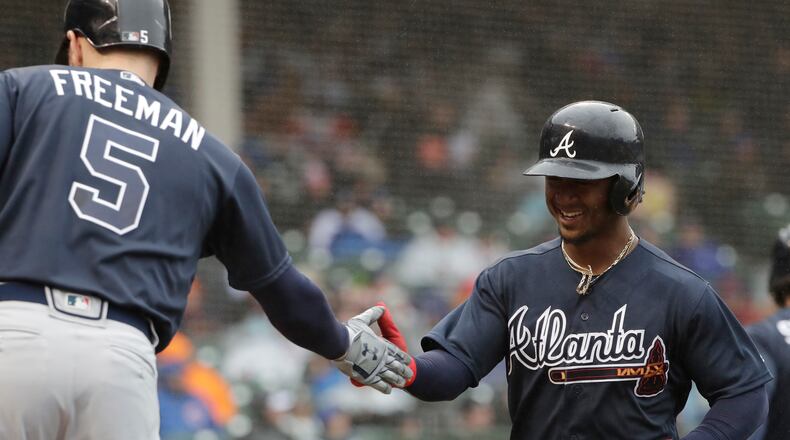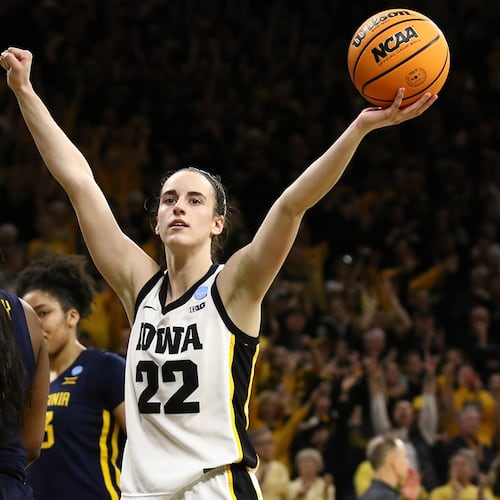Fourteen games in, the Braves have been pretty good overall and very good when wielding the warclub. (Old-time sports writing for “swinging the bat.”) They entered Monday’s game against the Phillies second among National League teams in runs, batting average and slugging percentage; they were first in on-base percentage and OPS. Given that they ranked in the top 10 in two of those categories – batting average (fourth) and OBP (ninth) – last season, this constitutes improvement.
But 14 games – we say again – do not a season make. (To be precise, they constitute 8.6 percent of a season.) None of the Braves’ production has come from Ronald Acuna, who’s still in Triple-A. So is Johan Camargo, last year’s improbable in-season sensation. Tyler Flowers, who had an OPS of .823 last season, hasn’t completed a big-league at-bat without hurting himself. The lineup most of us projected for April-and-beyond 2018 has yet to present itself, which hasn’t seemed to matter.
Cubs manager Joe Maddon, who saw the Braves chase Yu Darvish and Jose Quintana on consecutive days, called the visitors’ hitting “really impressive.” (Never mind that the Braves only split those games.) Given that the Braves haven’t seen much bad pitching – of their first five series, four were against 2017 playoff qualifiers – we can’t say they haven’t earned their gaudy numbers. We can, however, ask how gaudy those numbers are apt to remain.
To borrow from the Atlanta-based baseball writer Russell Carleton – Warning: Gory Mathematical Details Ahead! The sabermetric set has two go-to numbers when the question of sustainability arises, as is does with every player every April. For pitchers, it’s FIP, which stands for “fielding independent pitching.” If you have a low ERA but an inflated FIP, you mightn’t have a low ERA much longer. If you’re hitting like Ted Williams but you’re not Ted Williams (and there was only one of those), seamheads invariably consult BABIP.
It stands for “batting average on balls in play,” meaning it ignores strikeouts. The league BABIP over a full season is around .300, give or take. The biggest red flag that fluttered above Dansby Swanson’s two-month debut in 2017 was BABIP-related. He hit .302, which was dandy, but his BABIP was .382, which suggested he’d found a disproportionate number of holes. When his BABIP plunged to .292 in Year 2, his average dove to .232, which was why he was sent to Gwinnett to make room for Camargo.
As of Monday morning, Swanson was hitting .357, fifth-best among National Leaguers. A stirring rebound, yes? Absolutely. But again we check the data, and again we're reminded to hold our figurative horses. His BABIP was .442. The 2017 leader in BABIP among players with 400 plate appearances was Avisail Garcia of the White Sox – at .392.
Other Braves who won’t keep hitting the way they’ve been hitting are, duh, Ryan Flaherty and Preston Tucker. Both were low-budget offseason acquisitions. Flaherty is hitting .366, which leads the National League; Tucker is hitting .300 with 12 RBIs. If their sketchy pedigrees don’t fire off warning flares, BABIP does. Flaherty’s is .484, Tucker’s .321. (Freddie Freeman’s is .368, but he’s Freddie Freeman. No worries there.)
Lest this become a surgical strike in party pooping, we’re compelled to note the one Brave whose hot start might not be a false spring. This player is hitting .313, which is the same as his BABIP, which suggests he’s not just finding holes but hitting the ball really hard and really far. Not coincidentally, that player leads the majors in extra-base hits. That player is Ozzie Albies.
He’s 21. He’s the youngest among Braves, at least until Acuna arrives. As manager Brian Snitker noted Monday, Albies “has been the youngest kid on every team he’s ever been on, and this kid has never done anything except do well. He’s got a great skill set – he’s strong and he’s fearless. … We talk about adjustments – he’s shown the ability to adjust.”
Because Albies plays second base and is small of stature – he’s 5-foot-8, 165 pounds – the obvious contemporary comparison is Jose Altuve, who’d be the best player in baseball if Mike Trout retired tomorrow. Said Snitker: “That’s a lot to live up to, but I see the similarities. He’s a really charismatic young man.”
If there’s a knock on Albies, it’s that he doesn’t walk. (He has drawn one base on balls.) But he doesn’t strike out overmuch, either, and he absolutely drives the ball. He has eight doubles, one triple. His five home runs lead the Braves. We recall Joe Morgan, the Hall of Fame second baseman of similar dimensions, offering this description of his powerful self : “I’m not small; I’m short.”
Swanson may have been, albeit briefly, the Face of the Franchise, and Acuna is surely the club future’s, but Albies looks as if he has All-Star capability, and not the down-the-road kind. He arrived in the majors last August, and he’s already a keeper. “I like to challenge myself,” he said Monday, and his challenge now is simple: Keep doing what he’s doing. If BABIP is any guide, he darn well might.
About the Author
The Latest
Featured



